23/3/16
I just had an amazing experience. I went on an overnight trip to a place called Turtle Island off of the coast of Borneo. I’d heard about this from a guy I met while whitewater rafting last week on the Padas River. He’d gone a few years ago and when I heard what it entailed I knew I didn’t want to miss it. When I got to Sandakan, I immediately found a tour company and booked a spot for myself as soon as there was an opening.
I was picked up from my hotel yesterday morning and taken to the jetty by my guide, Terrence. There we met the rest of the people who would be going to the island that night. I believe 38 people went with me, though the island has a maximum capacity of 50 people per night.
At the jetty, we were divvied up and got onto some motor boats. It took over an hour to get to the island. The actual name of the island is Selingaan Island. On the way out of town, I had a lovely view of the mosque, which was built just over 10 years ago, and can hold over 2000 people. We also passed the “watertown” part of Sandakan. All of the houses here are on stilts over the water. They are quite colorful – not just the buildings, but also with the laundry hanging on lines outside of the homes, and with the plants hanging on balconies, etc., all signs of a thriving community. Quite beautiful.
I was pleased when we arrived at the island to see that it was surrounded by the clear waters I had hoped to find here. So far, I’d only been in the ports of Kota Kinabalu and Sandakan, where the waters are grey and murky and, sadly, quite full of garbage. It doesn’t look like the island paradise you hope to see in Southeast Asia, or like the type of water you look forward to scuba diving in! The itinerary for the day included a lot of free time to snorkel around the island, so I’d been hoping the water would look better than it had around the towns, and I was pleased to see the blues and greens of an island surrounded by reefs!
After getting settled into my room, I got some snorkel gear and headed out to the beach. I took a short swim and was pleased that the coral wasn’t quite as decimated as I’d been expecting, given the small-ish area that was roped off for visitors to use for swimming and snorkeling. So often, unaware tourists stomp around on coral and it ends up quite damaged and unhealthy in areas with so much traffic.
After a lunch break, I went back out to the beach for some lounging, reading and another good snorkel. I saw a bunch of beautiful spiny black sea urchins, parrot fish, and many types of coral. We were supposed to gather to watch a video at six, but the sun was setting right then, so everyone went out to the beach to watch the sunset first. Just as the sun was going down, I caught sight of a few turtles swimming off-shore, feeding, and sussing out the beach. At 6:30, the beach is considered “closed” to visitors. This is because that is when the rangers begin patrolling the beach, keeping an eye out for the mama turtles which begin coming ashore.
We all went into the main lodge to watch a film about the turtles and have some dinner. I also was given a lot of great information about the project by Terrence. He’s been working there for nearly 20 years! There are three islands here which are protected by the government and have been run since 1977 as a turtle-conservation project. In part because of its longevity, and in part because of the program’s commitment to excellence, literally millions of turtles have been hatched and have returned to this island to lay their eggs since then.
The rangers patrol the beach all night, watching closely for mother turtles to come ashore. When the do, the rangers wait until they have dug a hole for themselves. Once they have settled in and begin to lay their eggs, the guests are brought out to watch!
We all approached the turtle in the dark (although as it was a full moon, we had quite a bit of light to see!) from behind. She was already laying her eggs, and someone was sitting near her, gathering her eggs, several at a time, as she lay them. Apparently, turtles have hundreds of eggs inside which they can put out, and so emptying the clutch as they go encourages them to continue laying for a while longer. The mamas seem to go into some sort of trance as they birth, so they aren’t bothered by the presence of people once they’ve begun.
By the time she’d finished laying her eggs, there were 127 in total! She began covering up her clutch with sand (not realizing the hole was quite empty, a fact I found rather sad and hopeful all at once), and settled down to rest for a while. The rangers measured her – she was huge! – and checked her tags. This wasn’t the first time she had come to this beach to lay eggs.
By then, we had noticed another mother turtle beginning to crawl out of the sea and up the beach barely a hundred metres up the shoreline. Already, less than 20 metres away, just inland a bit, was another turtle, digging her hollow, who we had passed on our way to watch the first mother! Apparently this was the birthing suite area of the beach for the evening!
We all made our way back to the hatchery, so that the eggs could be safely buried and catalogued. The 127 eggs were placed together in a hole in the female section of the hatchery. They will probably be female because this area of the hatchery is not shaded, and the temperature remains a few degrees warmer than the other area. The temperature of the nest determines the sex of the turtles! In approximately 60 days, those eggs should hatch. About 5 days after that, the turtles will have climbed out of the sand to the surface!
After seeing those eggs safely into the ground, we went back to the beach with 40 newly hatched turtles, who had just finished digging their way to the surface from another nest while we’d eaten our dinner. These turtles, once set on the beach, began their hilarious, frantic run for the sea. I’d seen this wonderful phenomenon a year ago, in Mon Repos, Australia, when I visited with my friends Nate and Maraina. It was no less touching the second time!
I did, however, find myself quite irritated by the people who seemed to think that the turtles would not make it to the shore without their own personal assistance. The cries of: “Oh, that one’s not moving!” “I think it’s dead!” and “It’s going the wrong way!” became a bit much.
I must have said, “It’s fine. Just give it a minute. It’ll be alright. Just wait,” seventeen times, at least! I restrained myself from slapping their hands away as they reached in and pushed the poor little shell-shocked turtles around. I shared a few moments commiserating with Terrence after the little guys all were on their way, as he told me more stories of even more impatient visitors over the years. It’s very exciting, though. I can understand wanting to help, but the turtles need the chance to get their bearings and head out into the ocean! I’m not sure the pushing and shoving of the well-meaning guests does them any favours! And I’m certain they don’t need the lights of their cameras confusing them, as they use the moon- and starlight reflecting off of the ocean as their guide to the sea! Regardless, the turtles all made their way into the sea.
Very little is known about where turtles go after they leave their birthing beach and what they do during their early lives, but the amazing thing is that they return to the island of their birth to reproduce 25 to 30 years later. Somehow, they are able to feel the magnetic forces of the earth (through crystals in their brains) and can find their way back home. Chances are, the turtle we just saw lay her eggs was born on this island because of the conservation program that is still in progress. The island is interesting as it is surrounded by three different currents, which can take the turtles out to either the Sulu, Southern China, or Celebes Seas, depending on which side of the island they are released from. Varying the beaches where the turtles are released is helpful too because it can confuse the predators, hopefully causing less attrition. However since the area is a protected, no fishing zone, there are more predators in the water as well as more fish, so the area can be more dangerous for little turtles than is typical. The turtles we saw last night were green turtles, although they also have some hawksbill turtles who come to the island. Who knows how far these turtles have come to lay their eggs, or how far these babies will go before returning to do the same? Awe-some.
After all the excitement of the evening, it was pretty easy to head straight to bed after the babies were released. Plus, we were had a 6:30 breakfast scheduled the next morning before our boat ride back to Sandakan. In the morning, I walked along the beach and could see the turtle tracks, one track up to a freshly dug hole, and one set back to the water, all up and down the beach. Actually, it looked a bit like a 4×4 or jeep had come out of the water, and returned, but now that I knew what a turtle track looked like, and what each one of those marks and giant pits in the sand signified, the beach as full of wonder and life in the morning light.
It certainly was a fascinating and beautiful time. It was amazing to see the entire circle of the turtles’ reproductive process in one night under the light of that beautiful full moon. I’m so glad I took the trip out to Turtle Island. It’s not something I’m likely to ever forget.




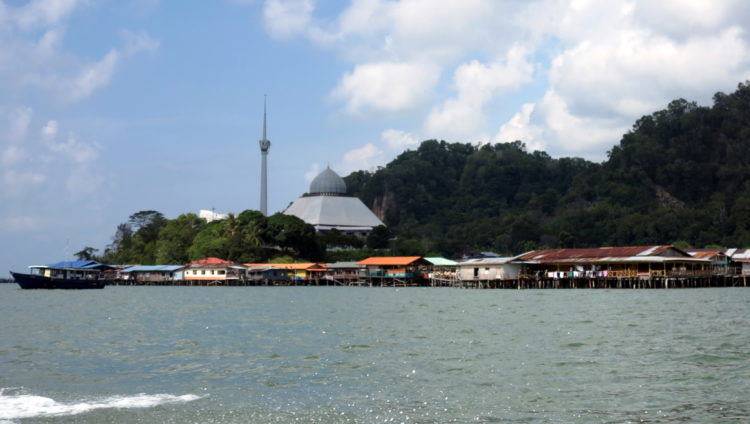
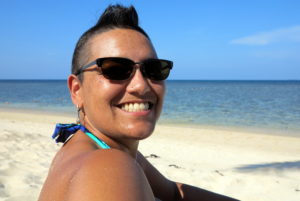

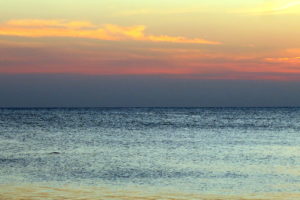
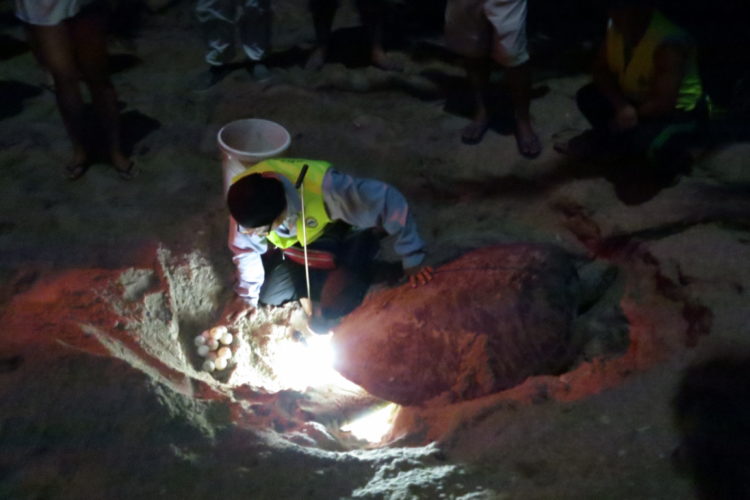

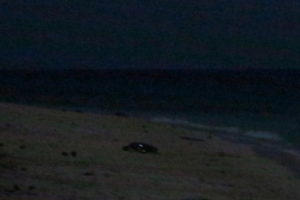
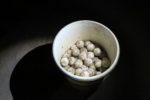
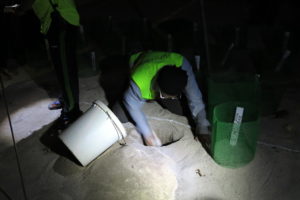

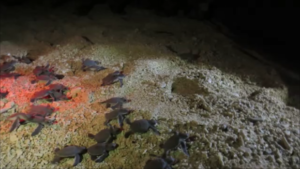
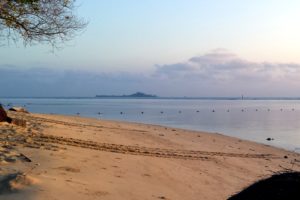
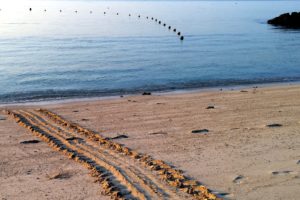
What an amazing experience to see the turtle laying and cycle of life!! You are one fortunate person to experience all these wonderful things!